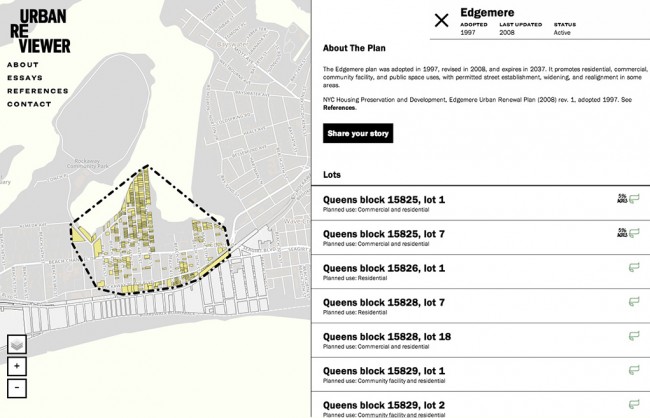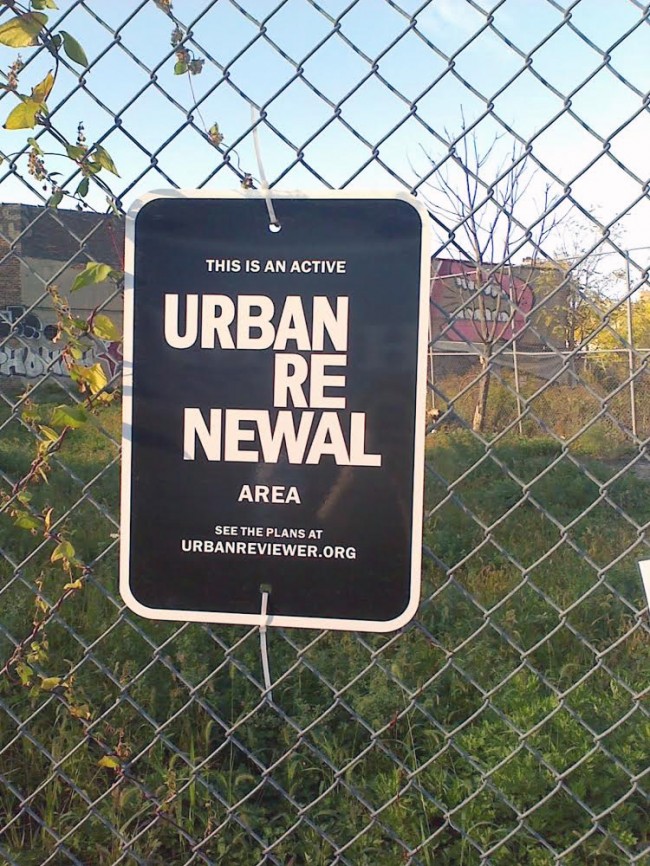
We are celebrating 15 years — and counting — of stories that are deeply researched and deeply felt, that build a historical record of what the city has been.
We are celebrating 15 years — and counting — of stories that are deeply researched and deeply felt, that build a historical record of what the city has been.

Urban Reviewer on Edgemere | Image via Urban Reviewer
In a July Roundup, we pointed you to a new visualization tool for tracking the plans that have shaped our city: Urban Reviewer, a project of open space advocacy group 596 Acres, design firm Partner & Partners, and sign retailer SmartSign, plots (almost) every urban renewal plan adopted in New York City. That’s 150+ neighborhood plans that have empowered the City to acquire wide swaths of land, clear them of existing uses where seen fit, and remake areas in line with the urban theories or economic development strategies of the day. Today, the nationwide urban renewal movement to clear “blighted” communities, ushered in by Title I of the Housing Act of 1949, carries highly negative associations, and rightfully so: plans often displaced vibrant communities to make way for misguided urban design and architecture that damaged far more than they renewed, or in some cases wiped everything away and left land fallow for decades to come (see: Arverne Urban Renewal Area in the Rockaways).
But as with many mechanisms and tools, the urban renewal plan, in and of itself, is value neutral. The plans were (and still are) used in some unforgivable ways, but in some cases have proved the basis for genuine and non-disruptive revitalization, as is the case with the Melrose Commons Urban Renewal Area in the South Bronx. The existing plan, adopted by the City in 1994 and active through 2034, was formulated by community-based organization Nos Quedamos with consultation from Magnusson Architecture & Planning and considered a model of inclusive revitalization. Paula Segal, 596 Acres’ executive director, also points to the work of the Cooper Square Committee, which formulated an alternative plan to the 1959 proposed demolition of eleven blocks on the Lower East Side between Bowery and 2nd Avenue for urban renewal purposes. The alternative plan was eventually adopted, and the area is now home to a pioneering community land trust that will maintain the affordability of housing units in the area in perpetuity.

Sign posted at 655 Flushing Avenue, part of the Broadway Triangle Urban Renewal Area | Photo by Jenny Akchin, courtesy of Urban Reviewer
Segal hopes that greater transparency can lead to significant community involvement in the implementation and revision of the city’s 62 active urban renewal plans. “We want to build an infrastructure to support more organizing and to scale the work of the Cooper Square Committee. No one has tried to scale this action. And there are opportunities in actually planning a whole neighborhood rather than looking at properties piece by piece.” As a first step, the group is implementing a signage strategy that they’ve used in their ongoing work to facilitate community access to publicly owned vacant land. In late October, signs in stark black and white proclaiming “This Is An Active Urban Renewal Area” started going up around Edgemere, Queens and Broadway Triangle, Brooklyn. Segal says that 596 Acres has started conversations with residents, non-profits, and city agencies about the Edgemere plan and that the signs will hopefully spur additional community interest in the process.
The Urban Reviewer team spent two years accessing all the community plans housed at the City’s Department of Housing Preservation and Development through Freedom of Information Law requests. Through their map, any resident can see some basics of each plan: year adopted, updated, or expired; all effected lots; and the new uses for those lots designated by the plan. The initiative also features a series of essays that explore different facets of urban renewal. Mariana Mogilevich, a historian of architecture and urbanism whose research focuses on the design and politics of the public realm, brings us a history of the policy and practice of urban renewal. Haja Worley, who co-directs a community garden in Harlem, reflects on his work with and the effectiveness of the Model Cities program, which aimed to make urban renewal more comprehensive and community driven between 1966 and 1973. Urban activist Matthew Delsesto and writer DW Gibson look at issues of contemporary community planning: Delsesto considers the tension between bottom-up and top-down processes in Boston, and Gibson muses on the nature of neighborhoods in today’s global economy.
So the next time you take in the fine arts at Lincoln Center or a Nets game at the Barclays Center, you can head home and look further into the master planning that brought them to fruition. And then you can peruse Urban Reviewer for information on your local urban renewal area. There’s a decent chance you’ve got one nearby, and it may well be active.
Correction: An earlier version of this article stated incorrectly that Urban Reviewer spent two years accessing urban renewal plans from the Department of Housing and Urban Development. Urban Reviewer accessed these plans from the New York City Department of Housing Preservation and Development.
The views expressed here are those of the authors only and do not reflect the position of The Architectural League of New York.
Comments